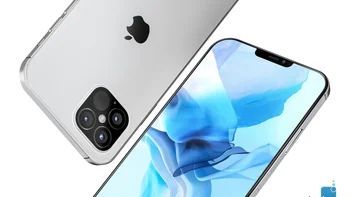Tech insiders suggest you should resist the temptation to upgrade to iPhone 12

This week, we saw a couple of images that apparently show the iPhone 12 Pro Max PVT (production validation prototype). The photos suggest that the notch has not shrunk when compared to the iPhone 11 Pro Max and this will probably not be taken well by consumers who have developed a liking for elevating cameras and pinholes seen on recent Android smartphones.
According to display industry insider Ross Young, this could change next year. He claims that the iPhone 12's successor could come with a hole cut out instead of a giant notch.
Now, the notch on iPhones houses Face ID sensors, and Young claims that the iPhone 13 might do away with them in favor of an in-display fingerprint scanner.
This is partially in line with what analyst Ming-Chi Kuo said last year. Kuo said Apple could bring back Touch ID in 2021 but claimed it wouldn't replace Face ID completely,
A later report alleged that Apple is planning to squish all the Face ID scanners together so that they would take up less space. This again lends substance to Young's recent prediction, who says that if Face ID stays, Apple will make the punch hole bigger to accommodate it.
Some recent reports also suggest that Apple is actively trying to make a high refresh rate work on the upcoming iPhone 12 Pro and iPhone 12 Pro Max. The images of the iPhone 12 Pro Max PVT shared by tipsters Jon Prosser and Filip Koroy hint that this would be an adaptive refresh rate, allowing the device to switch between 120hz and 60z depending on the content being displayed.
Even if the screenshots are legit, they do not guarantee a 120Hz display on the iPhone 12. Apparently, Apple is unable to arrange 120Hz driver ICs required for the 120Hz panels and it is currently trying to make the screen work with 60-96Hz driver ICs. It looks like the quality is still not good enough to commercialize this solution and thus, the company will probably stick with a 60Hz screen this year.
Alternatively, the company could delay the launch of the Pro models to resolve these issues.
Apple could introduce a pinhole screen next year
According to display industry insider Ross Young, this could change next year. He claims that the iPhone 12's successor could come with a hole cut out instead of a giant notch.
IPhone 12s or 13 will have LTPO, much more adaptive refresh, small hole instead of giant notch, hopefully 120Hz at full resolution, big display improvements even though sizes are the same...
— Ross Young (@DSCCRoss) August 26, 2020
Now, the notch on iPhones houses Face ID sensors, and Young claims that the iPhone 13 might do away with them in favor of an in-display fingerprint scanner.
A later report alleged that Apple is planning to squish all the Face ID scanners together so that they would take up less space. This again lends substance to Young's recent prediction, who says that if Face ID stays, Apple will make the punch hole bigger to accommodate it.
There is a very slim chance that the iPhone 12 would have a 120Hz display
Only some prototypes support 120Hz and the images don't seem all that authentic.
Even if the screenshots are legit, they do not guarantee a 120Hz display on the iPhone 12. Apparently, Apple is unable to arrange 120Hz driver ICs required for the 120Hz panels and it is currently trying to make the screen work with 60-96Hz driver ICs. It looks like the quality is still not good enough to commercialize this solution and thus, the company will probably stick with a 60Hz screen this year.
So the fix we have heard about is to make 60-96Hz driver ICs and make them work up to 120Hz by adjusting the refresh rate by 25%...Hope it works...
— Ross Young (@DSCCRoss) August 26, 2020
Alternatively, the company could delay the launch of the Pro models to resolve these issues.
Next year's iPhone will likely come with an LTPO panel which would make a dynamic refresh rate possible. Young also says that the iPhone 13 will support 120Hz at full resolution.
Analysts think the iPhone 12 will be the most significant product cycle for the company since the iPhone 6
A high refresh rate screen is far from the only factor that would make consumers buy the new iPhone. Most industry watchers expect the new 5G models to set off a super cycle and Wedbush analyst Dan Ives expects 350 million of the 950 million iPhones on the market to upgrade to a new model within the next 18 months.
The upcoming higher-end models are also expected to feature a LiDAR scanner, and this would be another incentive for consumers to get the iPhone 12.










Things that are NOT allowed: